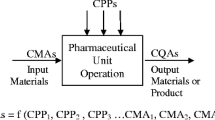Abstract
The purpose of this study was to determine the feasibility of applying accelerated in vitro release testing to correlate or predict long-term in vitro release of leuprolide poly(lactideco-glycolide) microspheres. Peptide release was studied using a dialysis technique at 37°C and at elevated temperatures (50°C–60°C) in 0.1 M phosphate buffered saline (PBS) pH 7.4 and 0.1 M acetate buffer pH 4.0. The data were analyzed using a modification, of the Weibull equation. Peptide release was temperature dependent and complete within 30 days at 37°C and 3 to 5 days at the elevated temperatures. In vitro release profiles at the elevated temperatures correlated well with release at 37°C. The shapes of the release profiles at all temperatures were similar. Using the modified Weibull equation, an increase in temperature was characterized by an increase in the model parameter, α, a scaling factor for the apparent rate constant. Complete release at 37°C was shortened from ∼30 days to 5 days at 50°C, 3.5 days at 55°C, 2.25 days at 60°C in PBS pH 7.4, and 3 days at 50°C in acetate buffer pH 4.0. Values for the model parameter β indicated that the shape of the release profiles at 55°C in PBS pH 7.4 (2.740) and 50°C in 0.1 M acetate buffer pH 4.0 (2.711) were similar to that at 37°C (2.577). The Ea for hydration and erosion were determined to be 42.3 and 19.4 kcal/mol, respectively. Polymer degradation was also temperature dependent and had an Ea of 31.6 kcal/mol. Short-term in vitro release studies offer the possibility of correlation with long-term release, thereby reducing the time and expense associated with longterm studies. Accelerated release methodology could be useful in the prediction of long-term release from extended release microsphere dosage forms and may serve as a quality control tool for the release of clinical or commercial batches.
Similar content being viewed by others
References
Ramstack M, Grandolfi G, Mannaert E, D’Hoore P, Lasser RA. Long-acting risperidone: prolonged-release injectable delivery of risperidone using Medisorb microsphere technology. Abstracts of the IXth International Congress on Schizophrenia Research.Schizophrenia Research. 2003;60(Suppl):314.
Kostanski JW, Thanoo BC, DeLuca PP. Preparation, characterization, and in vitro evaluation of 1- and 4-month controlled release orntide PLA and PLGA microspheres.Pharm Dev Technol. 2000;5: 585–596.
D’Souza SS, Selmin F, Murty SB, Qiu W, Thanoo BC, DeLuca PP. Assessment of fertility in male rats after extended chemical castration with a GnRH antagonist.AAPS PharmSci. 2004;6:E10.
Woo, BH, Na, K-H, Dani, BA, Jiang, G, Thanoo, BC, DeLuca PP. In vitro characterization and in vivo testosterone suppression of 6-month release poly(D,L-lactide) leuprolide microspheres.Pharm Res. 2002;19:546–550.
Okada H, Doken Y, Ogawa Y, Toguchi H. Preparation of three-month injectable micro spheres of leuprorelin acetate using biodegradable polymers.Pharm, Res. 1994;11:1143–1147.
Kane, JM, Eerdekens, M, Lindenmayer, J-P, Keith SJ, Lesem M, Karcher K. Long-acting injectable Risperidone: efficacy and safety of the first long-acting atypical antipsychotic.Am J Psychiatry. 2003;160:1125–1132.
Siewert M, Dressman J, Brown CK, Shah VP. FIP/AAPS guidelines to dissolution/in vitro release testing of novel/special dosage forms.AAPS PharmSciTech. 2003;4:E7.
Buchholz B. Accelerated degradation test on resorbable polymers. In: Plank H, Dauner, M, Renardy M, eds.Degradation Phenomena of Polymeric Biomaterials. New York, NY: Springer-Verlag; 1992:67–76.
Makino K, Arakawa M, Kondo T. Preparation and in vitro degradation properties of polylactide microcapsules.Chem Pharm Bull (Tokyo). 1985;33:1195–1201.
Bergsma JE, Rozema FR, Bos RRM, Boering G, Joziasse CAP, Pennings AJ. In vitro predegradation at elevated temperatures of poly(lactide).J Mater Sci Mater Med. 1995;6:642–646.
Reed AM, Gilding DK. Biodegradable polymers for use in surgery-poly(glycolic)/poly(lactic acid) homo and copolymers. 2. In vitro degradation.Polym. 1981;22:494–498.
Agarwal CM, Huang D, Schmitz JP, Athanasiou KA. Elevated temperature degradation of a 50∶50 copolymer of PLA-PGA.Tissue Eng. 1997;3:345–352.
Hakkarainen M, Albertsson A-C, Karlsson S. Weight losses and molecular weight changes correlated with the evolution of hydroxyacids in simulated in vivo degradation of homo- and copolymers of PLA and PGA.Polym Degrad Stabil. 1996;52:283–291.
Shameem M, Lee H, DeLuca PP. A short term (accelerated release) approach to evaluate peptide release from PLGA depot-formulations.AAPS PharmSci. 1999;1:E7.
D’Souza SS, DeLuca PP. Development of a dialysis in vitro release method for biodegradable microspheres.AAPS PharmSciTech. 2005;6:E42.
Rescigno A. Bioequivalence.Pharm Res. 1992; 9:925–928.
Costa P, Sousa Lobo JM. Modeling and comparison of dissolution profiles.Eur J Pharm Sci. 2001;13:123–133.
Polli JE, Rekhi GS, Augsburger LL, Shah VP. Methods to compare dissolution profiles and a rational for wide dissolution specifications for metoprolol tartrate tablets.J Pharm Sci. 1997;86:690–700.
Sathe PM, Tsong Y, Shah VP. In vitro dissolution profile comparison: statistics and analysis, model dependent approach.Pharm Res. 1996;13:1799–1803.
Hixson AW, Crowell JH. Dependence of reaction velocity upon surface and agitation.Ind Eng Chem. 1931;23:923–931.
Korsmeyer RW, Gurny R, Doelker E, Buri P, Peppas NA. Mechanisms of solute release from porous hydrophilic polymers.Int J Pharm. 1983;15:25–35.
Katzhendler I, Hofman A, Goldberger A, Friedman M. Modeling of drug release from erodible tablets.J Pharm Sci. 1997;86:110–115.
Langebucher F. Linearization of dissolution rate curves by the Weibull distribution.J Pharm Pharmacol. 1972;27:979–981.
Kervinen L, Yliruusi J. Modelling S-shaped dissolution curves.Int J Pharm. 1993;92:115–122.
Author information
Authors and Affiliations
Corresponding author
Additional information
Selected for the 2005 AAPS Outstanding Graduate Student Research Award in Pharmaceutical Technologies Sponsored by Solvay Pharmaceuticals.
Rights and permissions
About this article
Cite this article
D’Souza, S.S., Faraj, J.A. & DeLuca, P.P. A model-dependent approach to correlate accelerated with real-time release from biodegradable microspheres. AAPS PharmSciTech 6, 70 (2005). https://doi.org/10.1208/pt060470
Received:
Accepted:
DOI: https://doi.org/10.1208/pt060470




